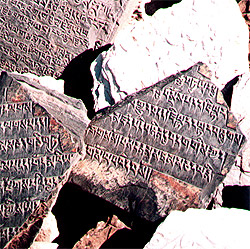Tibetan Grammar
Tibetans express themselves grammatically with the help of function words and different order of the words. Certain auxiliary words originating from verbs are playing an importan t role similar to that of the function words. Generally speaking, Tibetan words can be divided into nine types including nouns, verbs, numerals, adjectives, pronouns, conjunctions, adverbs, auxiliary words and exclamations. Verbs, adjectives, numerals and auxiliary words are to be discussed in the following part.
t role similar to that of the function words. Generally speaking, Tibetan words can be divided into nine types including nouns, verbs, numerals, adjectives, pronouns, conjunctions, adverbs, auxiliary words and exclamations. Verbs, adjectives, numerals and auxiliary words are to be discussed in the following part.
Verbs
Tibetan verbs can be divided into transitive verbs and intransitive verbs. Transitive verbs can be used to construct simple Tibetan sentences and it is required that an auxiliary word should be used after the subject so that the verbs can be in accordance with the subject. A typical Tibetan sentence is in the “subject-object-verb” order. This is one of the features of Tibetan transitive verbs. Tibetan verbs can also be classified as active verbs and passive verbs according to the restriction of the subject to the verb. This is another feature of Tibetans. The active verbs may have the imperative form,while the passive verbs may not.
Tibetan verbs are composed of two parts: the root, which carries the meaning of the verb, and the ending, which indicates the tense. There are eight uses of the verbs in Tibetans expressing different tense and voice. Basically, there are the present, past, future tense, the perfect tense, the progressive tense and the subjective mood. For example, the simplest and most common verb form, consisting of the root plus certain ending, can be used for the present and future tense; in order to form the past tense, substitute the ending or add the auxiliary word.
Adjective
There are two major functions of Tibetan adjectives: to modify a noun or to be predicative. When it is used in an indicative mood, it functions as an intransitive verb, which can only be followed by auxiliary word, not the object.
Numerals
Tibetan numerals are of the decimal system. The cardinal numbers consist of only one syllable. Different words are used to indicate the high-order number like hundred, thousand, ten thousand, a hundred thousand, ten million, and so on. Tens digit can be used together with number of ones place with slight difference in the pronunciation.
Auxiliary word
Auxiliary word can be added at the end of the verbs to indicate tense; it can be added between words or phrases to indicate different relationship between components of the sentence; it can also be added at the end of the sentence to indicate the mood.